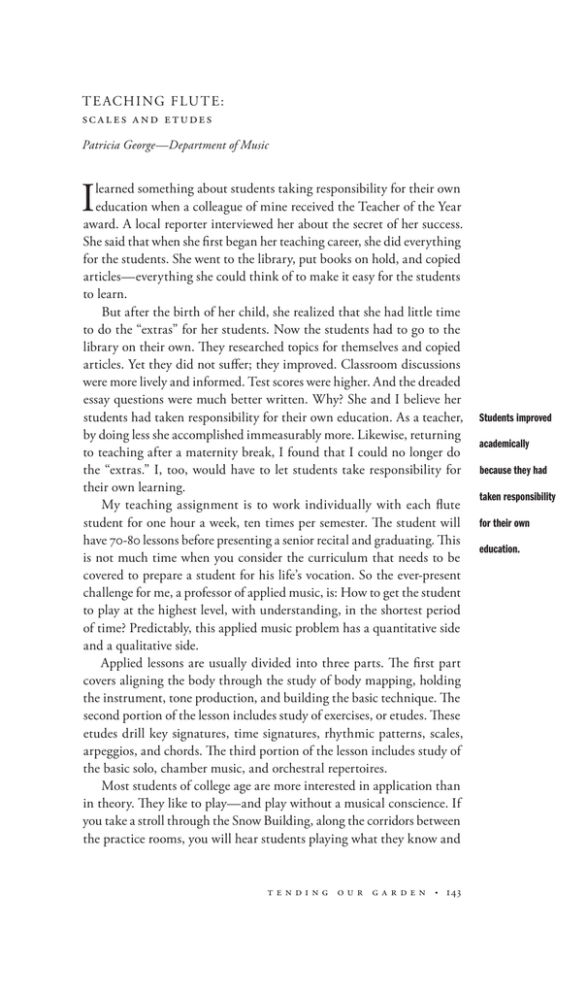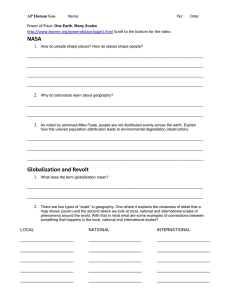i
advertisement

T e ac h i ng F lu t e : S c a l e s a n d E t u de s Patricia George—Department of Music I learned something about students taking responsibility for their own education when a colleague of mine received the Teacher of the Year award. A local reporter interviewed her about the secret of her success. She said that when she first began her teaching career, she did everything for the students. She went to the library, put books on hold, and copied articles—everything she could think of to make it easy for the students to learn. But after the birth of her child, she realized that she had little time to do the “extras” for her students. Now the students had to go to the library on their own. They researched topics for themselves and copied articles. Yet they did not suffer; they improved. Classroom discussions were more lively and informed. Test scores were higher. And the dreaded essay questions were much better written. Why? She and I believe her students had taken responsibility for their own education. As a teacher, by doing less she accomplished immeasurably more. Likewise, returning to teaching after a maternity break, I found that I could no longer do the “extras.” I, too, would have to let students take responsibility for their own learning. My teaching assignment is to work individually with each flute student for one hour a week, ten times per semester. The student will have 70-80 lessons before presenting a senior recital and graduating. This is not much time when you consider the curriculum that needs to be covered to prepare a student for his life’s vocation. So the ever-present challenge for me, a professor of applied music, is: How to get the student to play at the highest level, with understanding, in the shortest period of time? Predictably, this applied music problem has a quantitative side and a qualitative side. Applied lessons are usually divided into three parts. The first part covers aligning the body through the study of body mapping, holding the instrument, tone production, and building the basic technique. The second portion of the lesson includes study of exercises, or etudes. These etudes drill key signatures, time signatures, rhythmic patterns, scales, arpeggios, and chords. The third portion of the lesson includes study of the basic solo, chamber music, and orchestral repertoires. Most students of college age are more interested in application than in theory. They like to play—and play without a musical conscience. If you take a stroll through the Snow Building, along the corridors between the practice rooms, you will hear students playing what they know and tending our garden • 143 Students improved academically because they had taken responsibility for their own education. avoiding what they do not know. It is our mission to help students reverse this process. We encourage students to practice what they cannot do, which is to exercise musical conscience. Their being comfortable in their comfort zones, I learned, was inimical to my primary purpose—helping them take responsibility for their scholarship. Action-oriented students like to play their repertoire better than they like practicing basic skills that will eventually improve their repertoire. This means that students like to prepare for the third part of their applied lesson, but they resist preparing for the first two parts. Quantitatively, however, encouraging students to routinely practice these basic skills is essential to real growth. I love to play scales—yes, I love playing scales. My students know this well and usually know it before they enter BY U–I daho. They come to school with a mindset that much time will be spent with the revered Paul Taffanel & Philippe Gaubert 17 Big Daily Exercises. My best success at helping students to become independent learners was a by-product of assignments to practice scales, the most elementary musical rehearsals. Almost any Saturday at noon someplace in the Snow, you will find a group of flute players standing in a circle playing my Scale Game. Older students are teaching the game to the new students. Each year as the senior leader graduates, younger students vie for the position of leader of the Saturday scale game. It has become a position of importance. As the year progresses, the students become proficient at the Scale Game and begin to add the study of other aspects of building a technique—arpeggios, chordal studies, and melodic studies—to the Saturday routine. Improvement is strong, partially because of peer pressure. When you hear someone playing scales fast and evenly, you begin to say to yourself, “I need to be able to do that.” When new students join the group for the first time, the leader will say, “The first time you do these in a group, you will feel overwhelmed and like a loser. We all did. But, once you learn to play the scales in the group, to keep up, your playing I knew I was will have greatly improved.” One year a not-so-serious student complained to the Music Department becoming a more chair Jim Brague about my method of teaching scales. He asked her what successful teacher was wrong with the way I did scales. The student replied: “She does them all!” He showed no sympathy for her. And I knew I was becoming a because almost more successful teacher because almost all of my students were learning all of my students to enjoy practicing scales as I do. The quantitative side of the eternal challenge includes getting students were learning to through the core etude study. While etudes are always assigned, a student enjoy practicing often assumes that, if an etude was not heard in a lesson, it need not be learned for the next lesson. The basic etude curriculum for flute includes scales. 40 Studies by Luigi Hugues, 26 Selected Studies by Henri Altes, 96 Studies 144 • perspective—autumn 2007 by Joachim Andersen (Op. 33, 30, 63, 15), 30 Caprices by Sigfrid KargElert, and 12 Studies by Casterede. This is more than 200 etudes divided among 70 to 80 lessons. While many flutists in state institutions will never cover much of this repertoire, I am trying to give BY U–I daho students a conservatory-type education, the kind of curriculum one would learn at Juilliard, Curtis, Eastman, Oberlin, or New England Conservatory. My belief is that with this background plus the BY U–I daho music education background, our students will do well, very well, in their public school teaching careers. Besides getting students through the curriculum, there is the everpresent problem of quality. How well are the exercises executed? Generally the performance is not good enough. However, this past winter semester, I tried a new approach with great success. At the beginning of the term, I assigned a number of exercises to be learned each week from the etude book. If for some reason I did not hear all the etudes the following week, then the next week the student was responsible for last week’s assignment plus the new assignment. The student was required to bring all her etudes to the lesson in an audio recording. Some used the old-fashioned cassette, others burned CDs from laptop recordings, and several sent file attachments by email. As weeks passed, the recording quality improved. Students discovered which rooms had the best acoustics to record in. They learned about microphone placement. I suppose several learned something about editing. During the lesson we listened to the recorded performance together. When there were problems, I could stop the recording and explore solutions to the problem. Students became third party listeners to themselves and commented on their own performances, finding their own ways to play better. And play better they did. Almost every student’s performance improved by several levels. For a teacher of applied music, this is exciting stuff. During winter semester 2007, 17 flute majors and three flute minors learned and recorded more than 628 etudes. Quantitatively and qualitatively, the semester was a remarkable success. Education happened because students became their own critics and took responsibility for themselves. • tending our garden • 145 Students became third party listeners to themselves and commented on their own performances, finding their own ways to play better.



